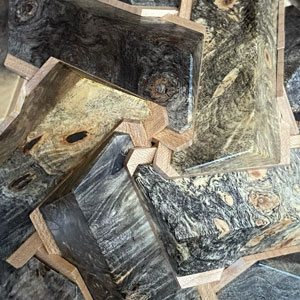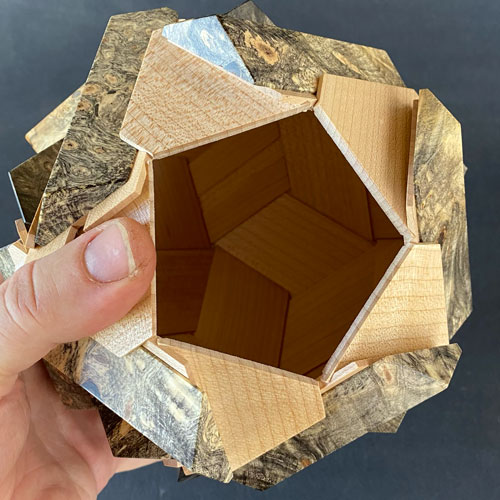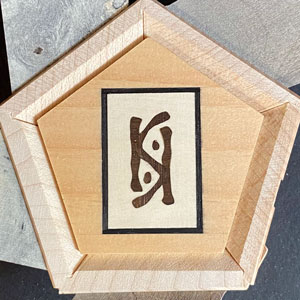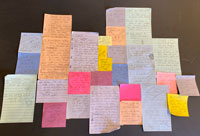
The Burly Hedgehog has a Maple structure with sliding Bastogne Walnut chunks. All of these move to unlock the box. It can be set to open with 47 or 26 moves including the final unusual lid movement.

Detail of an intersection. Some Buckeye burl chunks remind me of Van Gogh's "Starry Night".
 The pentagonal opening into the 30 sided belly of the Hedgehog.
The pentagonal opening into the 30 sided belly of the Hedgehog.
The Burly Hedgehog
Down the hedgehog hole...
Woodworking tends to be a right-angled craft. However, choose a pair of unusual angles and a world of magic unlocks! 63.436° and 36° are angles not often seen. Use these to make a pile of shapes and they can snap together into a crazy 30 sided structure called a Triacontahedron. Holding it feels different than any cube. It has its own personality, its own special set of strengths and weaknesses. It's alive!
Rhombic Triacontahedron (30 sides) |
Hedgehog structure (30 pieces) |
The ball-like structure has unusual architectural strength generated by wedging the parts together at the joints. Thin walls make up a shell with a massive interior like an egg. Joints don’t need glue to hold the shape together allowing both rigid strength and flexibility. A huge advantage for wood as it can now handle massive humidity changes without exploding or binding any moving parts. The structure itself seemed to beg for dovetail chunks. A lovely puzzle mechanism is materializing before my eyes. What could possibly go wrong?
At any given point you could take a snapshot of my perfectionism with sticky notes. I use different colors, sizes, and types of stickies all over my wood shop during a project to remind me of any small changes and edits to be made. Somewhere in the second half of the Hedgehog production I looked up and realized these notes had sprawled all over my workspace; 3 on my table saw, 8 on my workbench, another 8 on my finishing area. More were scattered about on my drill press, routers, and sanding areas. Stickies suggesting edits and modifications were clogging up my workflow!
Looking back on the project, I noticed about half my sticky notes were edits to my finish.
I hit a breaking point after revising my fourth finishing formula for the “supposedly easy to make” sliding chunks. I held up a recently finished chunk in one particular obscure corner of my studio where the light is distorted and hits the wood at a different angle. It revealed an ever so slight inconsistency in the shine of the wood. Everywhere else it looked fine, but not here. I felt so defeated. I knew I was over-perfecting, as I always do, and I couldn't make my peace with the finish. The wood was getting the best of me.
I decided to reach out for help from a more experienced woodworker, something I should do more often. I had taken a break from it all and realized my obsessive thinking was getting the best of me. His advice helped me greatly. More importantly I felt less alone with it all sharing my delimma. It nudged me closer to feeling like the Hedgehogs were good enough. Not only that, they are amazing! They pushed me into a new and uncomfortable place mathematically, artistically, and taught me a little humility. It was time to feel proud and usher them out the door into the great wide world.
While archiving all the stray parts, prototypes, jigs, and notes of the Hedgehog project, I found the original 30 sided prototype. I dusted it off, and found just one sticky note left on it. The 2 magic angles! 63.436° and 36°. I taped this in with the giant multicolored mass of other notes.
|

 The underside of the lid.
The underside of the lid.  A collection of notes documenting the improvements and edits to the project. It also gives me a snapshot of my own perfectionism. About half the less urgent Hedgehog stickies were lost or thrown away during the course of the production.
A collection of notes documenting the improvements and edits to the project. It also gives me a snapshot of my own perfectionism. About half the less urgent Hedgehog stickies were lost or thrown away during the course of the production.